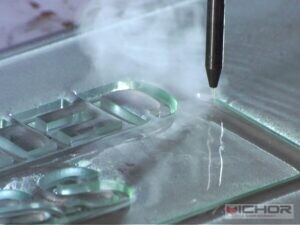
Laser Microjet Machine Price: A Comprehensive Guide to Costs and Factors
When investing in advanced cutting technology, understanding the laser microjet machine price is crucial for making an informed decision. Laser Microjet technology combines laser precision with water jet guidance, offering unique advantages for various industries. In this guide, we’ll explore the key factors affecting laser microjet machine price, compare different models, and provide insights into cost-saving strategies.
1. What is a Laser Microjet Machine?
A laser microjet machine is a hybrid cutting system that uses a laser beam guided by a thin water jet. This innovative approach minimizes heat-affected zones, reduces material distortion, and enables high-precision cutting. Industries such as electronics, medical devices, and aerospace frequently use this technology for delicate and complex cuts.
The laser microjet machine price varies depending on its capabilities, including power output, cutting speed, and automation features.
2. Key Factors Affecting Laser Microjet Machine Price
Several factors influence the laser microjet machine price, including:
A. Laser Power and Cutting Capability
Higher-power lasers (e.g., 500W to 1000W) can cut thicker and harder materials but come at a higher cost. Lower-power machines (100W–300W) are more affordable but may have limitations in material thickness.
B. Machine Size and Work Area

Larger work envelopes (e.g., 1m x 1m vs. 2m x 3m) increase the laser microjet machine price due to higher structural and component costs.
C. Automation and Software Features
Fully automated systems with advanced CNC controls, robotic integration, and AI-assisted cutting will be more expensive than manual or semi-automated models.
D. Brand and Manufacturer Reputation
Well-known brands like Synova (the pioneer of Laser Microjet technology) typically charge a premium compared to newer or lesser-known manufacturers.
E. Additional Accessories and Maintenance Costs
Cooling systems, water filtration units, and extended warranties can add to the overall laser microjet machine price.
3. Average Price Range of Laser Microjet Machines
The laser microjet machine price can range from $150,000 to over $500,000, depending on specifications. Here’s a breakdown:
Entry-level models (100W–200W): $150,000–$250,000
Mid-range models (300W–500W): $250,000–$400,000
High-end industrial models (500W+ with automation): $400,000–$600,000+
Used or refurbished machines may cost 30%–50% less but come with potential risks in performance and longevity.
4. Cost Comparison: Laser Microjet vs. Traditional Laser Cutting
While the laser microjet machine price is higher than conventional CO2 or fiber laser cutters, the benefits justify the investment:
| Feature | Laser Microjet | Traditional Laser |
|---|---|---|
| Precision | Ultra-fine cuts (µm-level) | Limited by thermal effects |
| Heat Impact | Minimal (water-cooled) | High (risk of material warping) |
| Material Versatility | Cuts metals, ceramics, composites | Mostly metals & plastics |
| Operating Cost | Higher (water filtration) | Lower (no water jet system) |
For industries requiring extreme precision, the higher laser microjet machine price is often offset by reduced material waste and superior cut quality.
5. How to Reduce the Cost of Owning a Laser Microjet Machine
A. Leasing or Financing Options
Many manufacturers offer leasing programs, reducing upfront costs and allowing businesses to pay in installments.
B. Buying Refurbished or Pre-Owned Machines
Certified refurbished machines can offer significant savings while maintaining performance.
C. Optimizing Consumables and Maintenance
Regular maintenance and efficient water filtration can extend machine life and lower long-term costs.
D. Government Grants and Subsidies
Some regions offer incentives for adopting advanced manufacturing technologies, helping offset the laser microjet machine price.
The laser microjet machine price is influenced by factors such as power, size, automation, and brand reputation. While the initial investment is substantial, the technology’s precision and versatility make it a valuable asset for high-tech industries. By comparing models, exploring financing options, and optimizing operational costs, businesses can make a cost-effective investment in Laser Microjet technology.
If you’re considering purchasing a laser microjet machine, request quotes from multiple suppliers and evaluate total ownership costs to find the best solution for your needs.
continue reading
Related Posts
- 1371 words6.9 min read
- 1449 words7.3 min read


